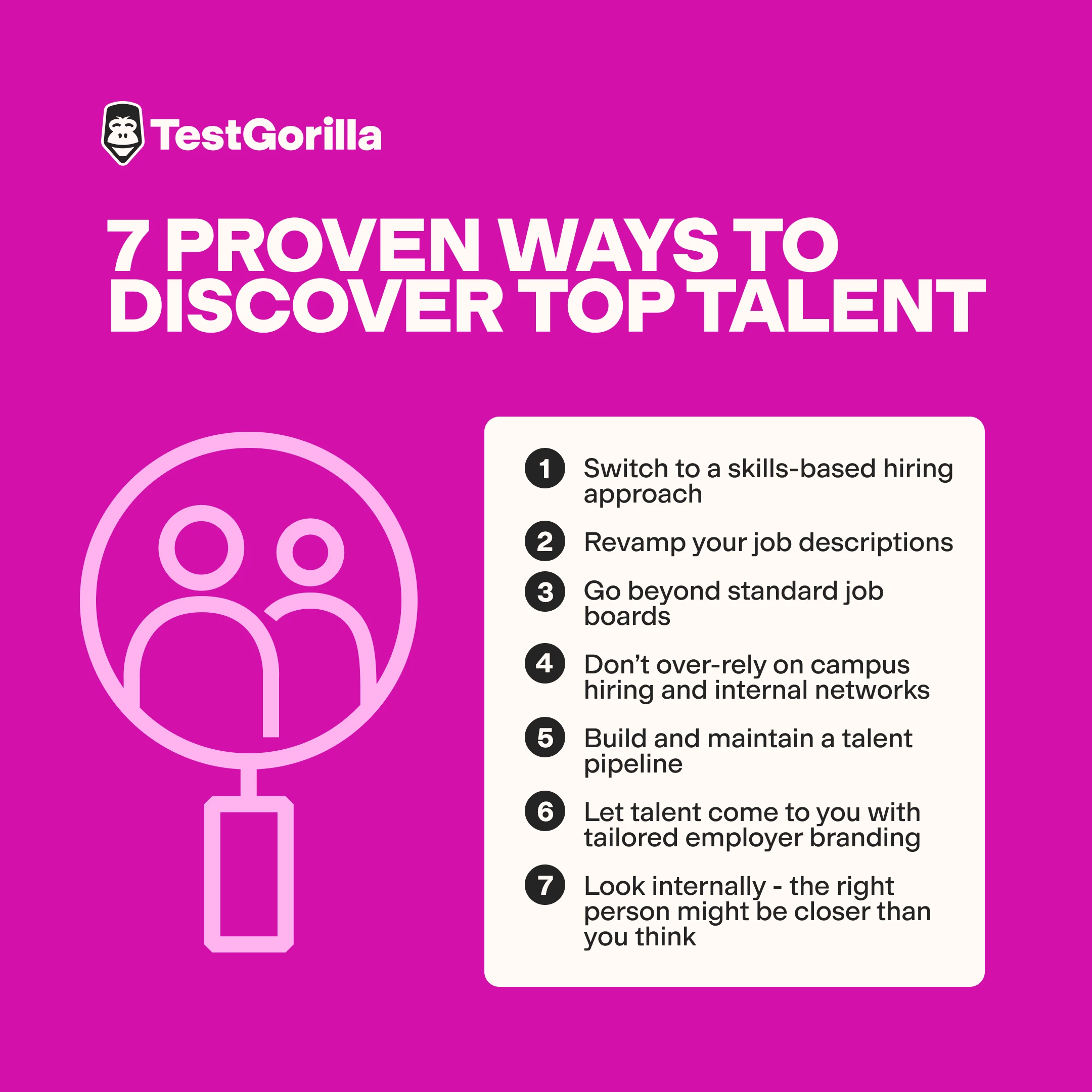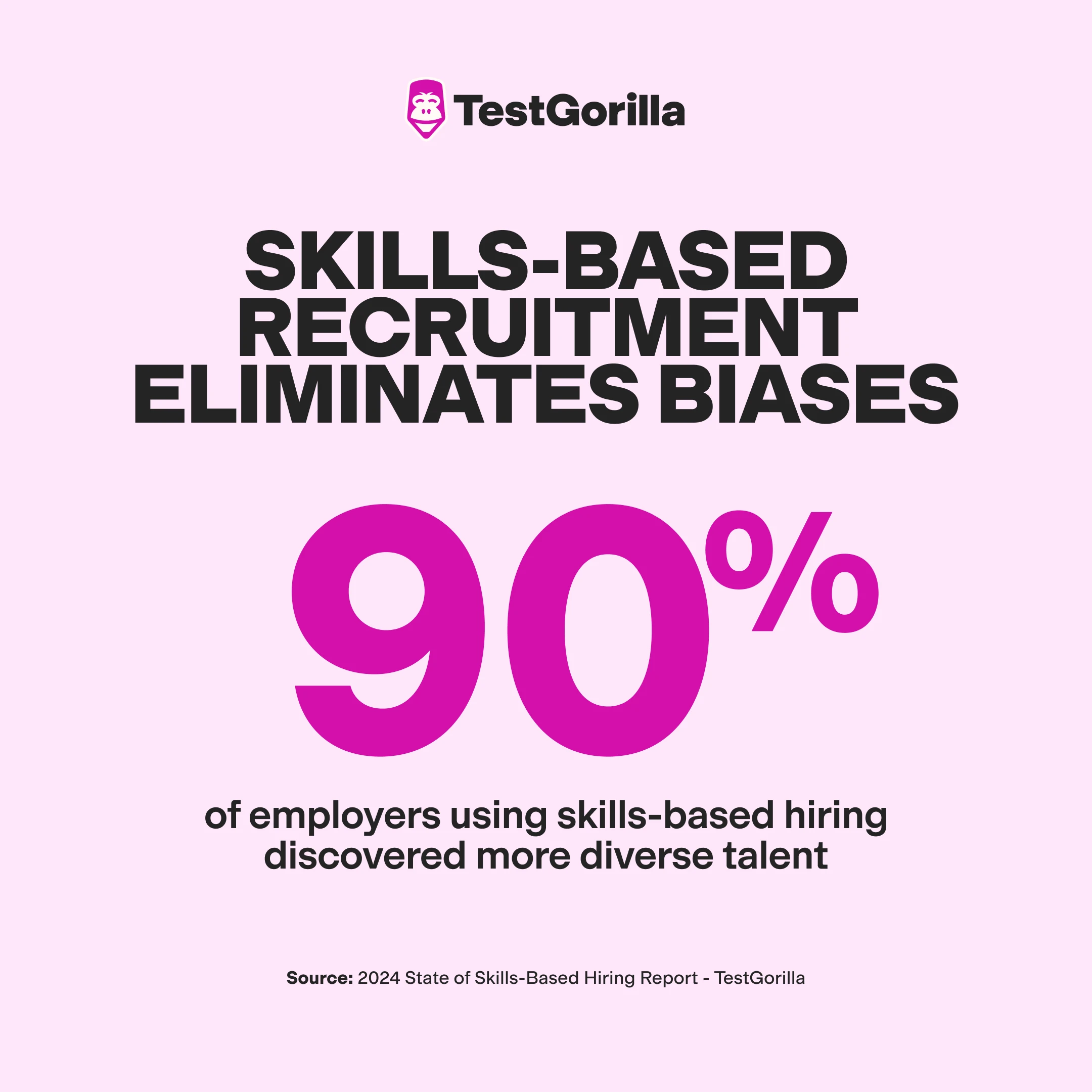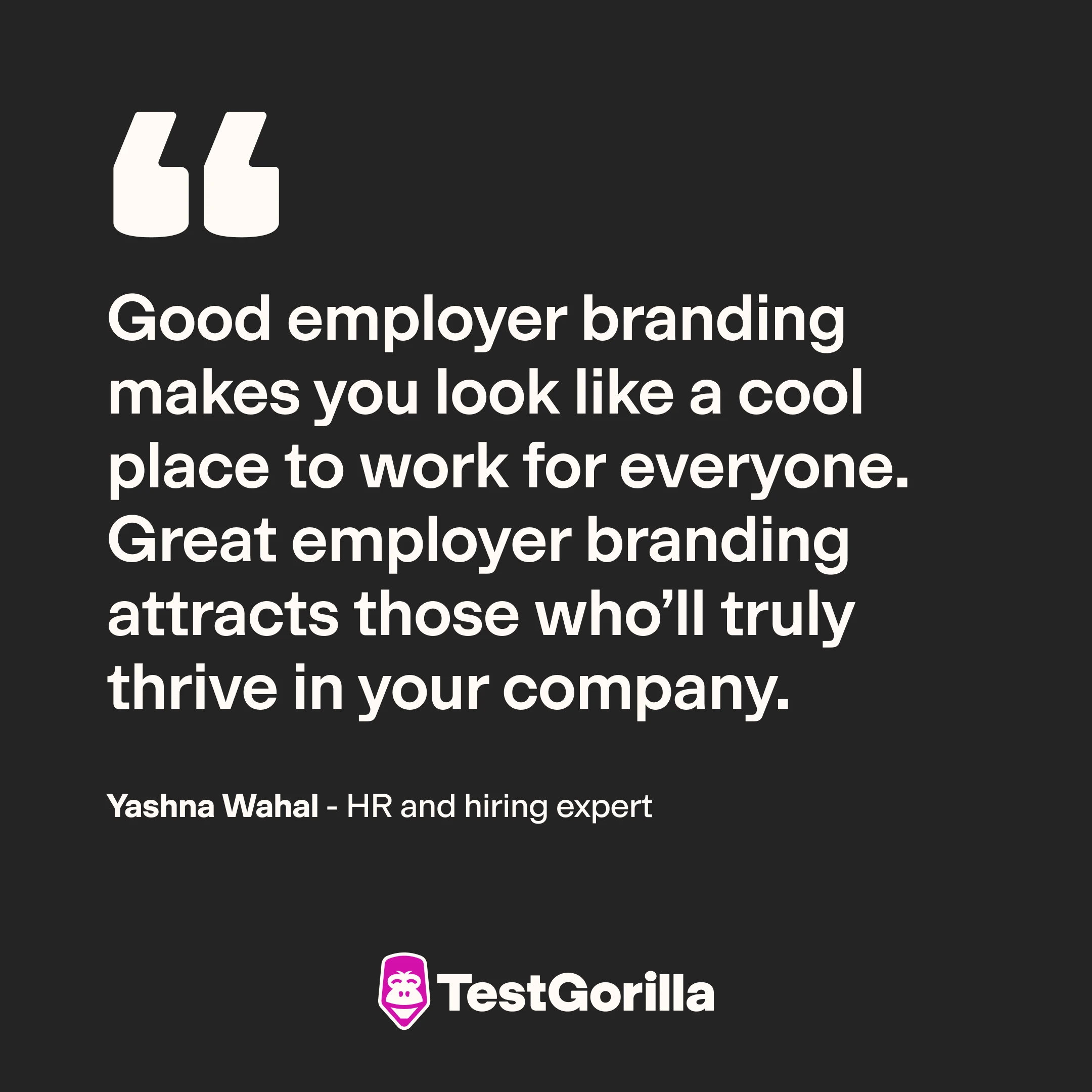The last few years have seen a tight labor market, with more open positions than skilled candidates to fill them. But with recent layoffs in tech and a cooling landscape, the market is now teeming with candidates just waiting to be discovered.
Despite this, however, 51% of employers say it’s harder to find top talent in 2024 than last year.
Why is it still so hard and frustrating to find good talent?
We think the issue isn’t talent shortage – it’s talent discovery, and we’re here to help.
In this article, we share 7 proven talent discovery tips to help you find and recruit candidates who fit your company like a glove.
Table of contents
- What is talent discovery?
- 1. Switch to a skills-based hiring approach
- 2. Revamp your job descriptions
- 3. Go beyond standard job boards
- 4. Don’t over-rely on campus hiring and internal networks
- 5. Build and maintain a talent pipeline
- 6. Let talent come to you with tailored employer branding
- 7. Look internally - the right person might be closer than you think
- Discover the best talent for your company with TestGorilla
What is talent discovery?
Talent discovery is the process of finding and attracting the right people for a job. But it's more than just filling open positions. Good talent discovery is about finding hidden gems whose skills, potential, and cultural values perfectly match your company’s needs – even if they weren’t an obvious fit at first glance.
Below are 7 proven ways to discover top talent in today’s job market.
1. Switch to a skills-based hiring approach
A skills-based recruitment approach focuses on hiring candidates for their real-world skills and abilities instead of education, background, or years of experience.
How does it help with talent discovery?
It widens your talent pool to include non-degreed candidates who’ve acquired skills through self-learning, online courses, hands-on training, and other means.
It eliminates biases, such as looking for a specific gender, demographic, or background – all irrelevant to job performance. In our 2024 State of Skills-Based Hiring Report, we found that 90% of employers using skills-based hiring discovered more diverse talent.
It highlights candidates’ potential so you can discover talent that could shine in a role with the right opportunity. Our research concluded that 63% of employers felt skills-based methods helped them see people for their potential rather than just their experience.
Candidates like it, with 85% telling us it helps them showcase their skills and 90% saying they’re more likely to secure their dream job with skills-based hiring.
Tracy Davis, CEO of TRAX Analytics, shared their first-hand experiences with skills-based hiring:
We focus on skills, not degrees or connections. For example, when hiring developers, we assess programming skills and logic abilities, not just education. We’ve found bootcamp grads and self-taught coders who've become top performers.
Here’s how you can discover the best talent with a skills-based hiring approach:
Remove degree requirements from job postings
Eliminate the need for college degrees from your job postings. This opens the doors to skilled applicants who can excel in a role but don’t have the resources to complete higher education.
Use talent assessments to screen applicants
Ditch using resumes as the first step of your screening process. These list candidates’ skills and experiences but don’t let you verify their capabilities. Plus, resume screening can introduce biases – for instance, favoring candidates who share your hobbies rather than those who are skilled.
Instead of resumes, use online talent assessments to screen initial applications. By putting candidates through skills tests relevant to the role, you can:
Make objective and data-driven screening decisions.
Shortlist talent that could have slipped through the cracks if you’d merely screened their resumes.
Allow remote candidates to showcase their skills so you can discover talent anywhere in the world.
Opt for multi-measure testing
Multi-measure tests help you evaluate candidates on more than just hard skills. You can assess soft skills such as communication and management, cognitive abilities like problem-solving and critical thinking, and even applicants’ personality traits.
Using a multi-measure testing approach, you can get a holistic view of your candidates’ capabilities, which is crucial for discovering their potential.
Let’s say you’re hiring for a customer success role and find a candidate who isn’t familiar with your product but excels in communication and problem-solving like no other applicant.
You could hire this candidate, train them on the product, and watch them shine in your company. Without multi-measure testing, they wouldn’t have had the opportunity to showcase their strengths, and you’d never have discovered them.
The best insights on HR and recruitment, delivered to your inbox.
Biweekly updates. No spam. Unsubscribe any time.
2. Revamp your job descriptions
Poorly written job descriptions can stand in the way of talent discovery by confusing potential candidates and deterring them from applying for roles. This means your perfect candidate might never enter the hiring funnel!
Here’s how you can write great job descriptions to discover ace talent for your team.:
Use straightforward language to describe the role, responsibilities, and what you’re looking for. If candidates don’t understand what you’re looking for or feel overwhelmed by big words and technical terms, they’re less likely to apply. It’s helpful to assume you’re writing the job description for non-native English speakers.
Focus on the must-have skills. This not only attracts qualified candidates but also is less overwhelming than if you included every skill you can think of for the role. Plus, it ensures your job description is specific and reflects the position’s needs. This specificity is important since only 5% of recruiters and hiring managers feel their job descriptions accurately reflect their open roles.
Use inclusive language that doesn’t limit your role to specific genders, ages, races, and so on. For example, instead of saying you need a “young and energetic” candidate, consider saying “dynamic and enthusiastic.”
Talk about your company. Don’t miss the opportunity to showcase your company’s core offering, why it’s great in its field, and what its culture is like. This will help you attract skilled candidates with a passion for what your company is all about.
Highlight what’s in it for them. Clearly state the benefits, perks, and any flexible working arrangements to make the job appealing to candidates. Additionally, mentioning opportunities for career progression is a good way to discover talent interested in working hard and growing with your company.
3. Go beyond standard job boards
While popular job boards like LinkedIn, Monster, Indeed, etc., are great for casting a wide net, they’re not ideal for finding your perfect match.
Why?
Job boards bring you a high volume of applicants, many of whom are unqualified for the role. Candidates often apply to multiple positions without carefully reading and understanding the role’s requirements.
For employers, this means sifting through countless irrelevant resumes, which is not only time-consuming and tedious but can also get tiring enough to miss the good ones. Additionally, job boards only touch active job seekers, missing out on passive candidates who are a significant portion of the talent pool.
In fact, one study found that it takes 46 applications for every quality hire through a job board. Compare this to 26 applications on company career pages, and five or fewer applications through internal mobility schemes, employee referrals, or talent pipelines for every hire. Findings also showed that only 20% of successful hires come from job boards.
So, where else can you look for top talent?
Niche job boards
Niche job boards focus on a specific industry or sector – such as software development or engineering – making it easier to discover candidates who are experienced in that space and match your needs.
These job boards might get you fewer applications, but they’ll be higher quality and more relevant.
Skills-based job boards
You can now also use skills-based job boards to find candidates you could have easily missed on Indeed, LinkedIn, etc. When you post an open role on TestGorilla’s job board, for example, candidates take skills tests tailored to the role as the first step of the application process.
This way, you can be matched with applicants with verified expertise in what you’re looking for rather than needing to screen hundreds of low-quality applications. Plus, you discover skilled candidates you might have rejected on a traditional job board for not meeting criteria such as years of experience, college degrees, etc.
Recruiting and headhunting agencies
Recruiters and headhunters have access to extensive networks of potential applicants, including passive candidates who might not be looking for new jobs but could be open to the idea. Additionally, they’re a great way to source senior talent or those with specialized skill sets.
Pro tip: Don’t leave recruitment entirely to an agency. Let them participate in talent discovery but get involved in assessing candidates’ skills and culture match.
4. Don’t over-rely on campus hiring and internal networks
Most employers engage in some form of campus recruiting, but this can be extremely limiting. For starters, it doesn’t affect the quality of hires. An article published in the Harvard Business Review showed a weak correlation between degrees and job performance.
Additionally, many roles today – such as graphic design and coding – can be learned through online training, hands-on experience, and self-instruction. By focusing recruitment efforts on soon-to-be college grads means you miss out on the opportunity to discover non-graduates and STAR (Skilled Through Alternate Routes) candidates who could have been top performers.
As legal writer Kate Stacey explains, campus hiring can also keep you from reaching “people from refugee backgrounds, with criminal histories, from countries where higher education opportunities are limited [...] older workers, and minority groups.”
Similarly, many companies seek applicants through known networks such as employees’ personal or professional connections and company leaders’ family members.
While it’s tempting to explore this avenue, you’re limiting yourself to a specific social and demographic makeup and losing out on talented individuals from different backgrounds.
That’s why you should consider exploring other local and online communities. For instance, advertising your open roles at local coworking spaces can give you access to a diverse group of active and passive candidates interested in the job.
You can also tap into industry-specific communities in your area – such as TechTown Detroit, which is brimming with top tech talent in Detroit.
Furthermore, join online communities like GrowthHackers to find marketers, product managers, and entrepreneurs or the Society for Human Resource Management (SHRM) to hire for HR roles.
This helps you discover people with the right skill set and, if you’re open to remote work, applications from a global audience.
5. Build and maintain a talent pipeline
A talent pipeline is a proactive recruiting approach in which you keep a pool of potential candidates ready to fill job openings as they arise. This way, you can reduce your time to hire and focus on discovering the right fit rather than sourcing talent from scratch.
One study by WilsonHCG, a global talent solutions provider, showed that 67% of employers are building talent pipelines to help with faster and better recruitment for future roles. Here’s how you can create one yourself:
Identify relevant skills
Creating and maintaining a skills ontology is the first step to identifying which candidates to add to your talent pipeline.
“Skills ontology” might sound complicated, but it’s simply a framework that covers the skills within your company.
Start by thinking about the positions key to your company’s success and what skills are required for them. Then, consider how the industry is shaping up so you can list the skill sets you’ll need to hire for even in the future. For instance, if you want to use more artificial intelligence in the long term, you might want to add AI skills to the list.
Invest in talent mapping
Take time to identify and track top performers in the industry who could be suitable for future roles in your company. You can do this by looking for prominent individuals on LinkedIn and people who’ve won awards in relevant fields. You can also attend industry meet-ups to connect with star talent.
Keep a record of where these individuals are currently working, what skills they have, and when they might become available.
Track memorable applicants who didn’t make the cut
Remember those impressive applicants who once made it to the final stages of the hiring process but didn’t make the cut? Add them to your talent pipeline. This way, when a role opens up, you can quickly tap into those who’ve already proven themselves worthy and are actively interested in working for your company.
Keep passive candidates engaged
Have you considered using a customer relationship management (CRM) platform to manage and engage your candidate pipeline?
This technology can help you build your pipeline, storing detailed records of candidates’ profiles, skills, and communication history with your company.
With a CRM system, you can also track and manage interactions with candidates and even send them personalized messages, industry insights, company newsletters, and more.
6. Let talent come to you with tailored employer branding
Most companies have jumped on the employer branding bandwagon over the last few years – and rightfully so. When your employer brand is impressive, the best talent comes to you.
However, that’s all easier said than done. Your company’s reputation, value proposition, and employee experience contribute to your employer brand, and you’ll have to go the extra mile to make it exceptional.
As HR and hiring expert Yashna Wahal explains:
The problem is that companies are implementing generic strategies to improve their employer brand. Everyone’s calling themselves flexible and trying to sell ‘beer Fridays.’ Not only is this not unique, but it also doesn’t help you attract the right people.
When you’re talking about your company on your website, careers page, social media, and offline events, here’s what to keep in mind:
Define your unique value proposition
Spotlight what makes your company’s mission and work stand out.
For example, a construction company can focus on green construction and its commitment to sustainable practices. This can help attract candidates who are particularly passionate about eco-friendly construction practices and prevent applications from those looking for something more traditional.
Speak to your target audience
Use language and content that speaks directly to the talent you want to attract. For instance, a medical facility might use technical language and have a serious tone of voice to appeal to the right healthcare professionals.
Additionally, be honest and clear about what it’s like to work for your company. For example, be upfront if you need employees to work on public holidays. This is a great way to avoid applications from those who wouldn’t vibe with your working practices.
Use employee testimonials
There’s no better PR than first-hand employee accounts. Share testimonials and stories from team members who resonate with your company's culture and values. This is a great way to help potential candidates visualize themselves in similar roles.
7. Look internally - the right person might be closer than you think
Who said good talent can only be found externally? If you look carefully, you’ll find your own company full of top-notch talent. These are people who already know what it’s like to work at your organization and are familiar with its culture.
By recruiting internally, you allow existing employees a chance to grow and take on new roles. This helps you fill your open positions and leads to greater job satisfaction.
Here’s how to do it:
Conduct regular skills evaluations for all employees. This can be in the form of skills tests. Or, you can add a “skills” section as part of your performance review template and have managers regularly list and rate their employees' hard and soft skills.
Track growth interest. Maintain a record of employees looking for more challenging work, a move, or a promotion. Managers can share this information with HR after goal-setting or career development sessions with their teams. Employees can also speak to HR or a mentor about their desire to move internally.
Match workers to the position. When a role opens up, look at the employees with the skills needed for the job, especially if they’ve expressed interest in a new gig.
Provide training and support. Once you’ve discovered the right candidate, give them the training and resources they need for their new role so they’re set up for success.
Discover the best talent for your company with TestGorilla
Despite job markets easing, discovering the right talent has continued to be a challenge for many employers.
Using a talent discovery platform like TestGorilla is the best way to hire for skills, widen your talent pool, and discover candidates with the potential to excel.
Additionally, tightening your job descriptions, exploring local and online communities, and considering internal employees can help you find good candidates more easily.
Lastly, stay focused on building an employer brand that’ll help you attract the right folks, and continue building a talent pipeline that you can quickly tap into for your open positions.
With talent availability no longer a problem, these tactics can help you make the most of today’s job market and discover the best talent for your company.
You've scrolled this far
Why not try TestGorilla for free, and see what happens when you put skills first.





















